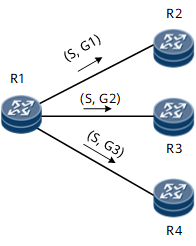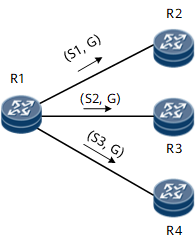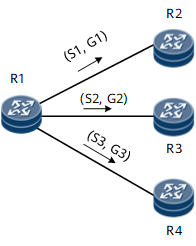Multicast Scenarios
Multicast Trunk Load Balancing
Multicast traffic can only be balanced per flow over trunk member interfaces. The hash factor is a triplet (multicast source IP address, multicast group IP address, and VPN instance).
Multicast Route Load Balancing
Multicast group-based load balancing
Based on this policy, a multicast router uses the hash algorithm to select an optimal route among multiple equal-cost routes for a multicast group. Therefore, all traffic of a multicast group is transmitted on the same forwarding path, as shown in Figure 1.
This policy applies to a network that has one multicast source but multiple multicast groups.
- Multicast source-based load balancing
Based on this policy, a multicast router uses the hash algorithm to select an optimal route among multiple equal-cost routes for a multicast source. Therefore, all traffic of a multicast source is transmitted on the same forwarding path, as shown in Figure 2.
This policy applies to a network that has one multicast group but multiple multicast sources.
- Multicast source- and group-based load balancing
Based on this policy, a multicast router uses the hash algorithm to select an optimal route among multiple equal-cost routes for each (S, G) entry. Therefore, all traffic matching a specific (S, G) entry is transmitted on the same forwarding path, as shown in Figure 3.
This policy applies to a network that has multiple multicast sources and groups.
- Stable-preferred
Based on this policy, a multicast router distributes (*, G) entries and (S, G) entries on their corresponding equal-cost routes. Therefore, stable-preferred is similar to the balance-preferred policy. This policy implements automatic load balancing adjustment when equal-cost routes are deleted. However, dynamic load balancing adjustment will not be performed when multicast routing entries are deleted or when weights of load balancing routes change.
This policy applies to a network that has stable multicast services.


